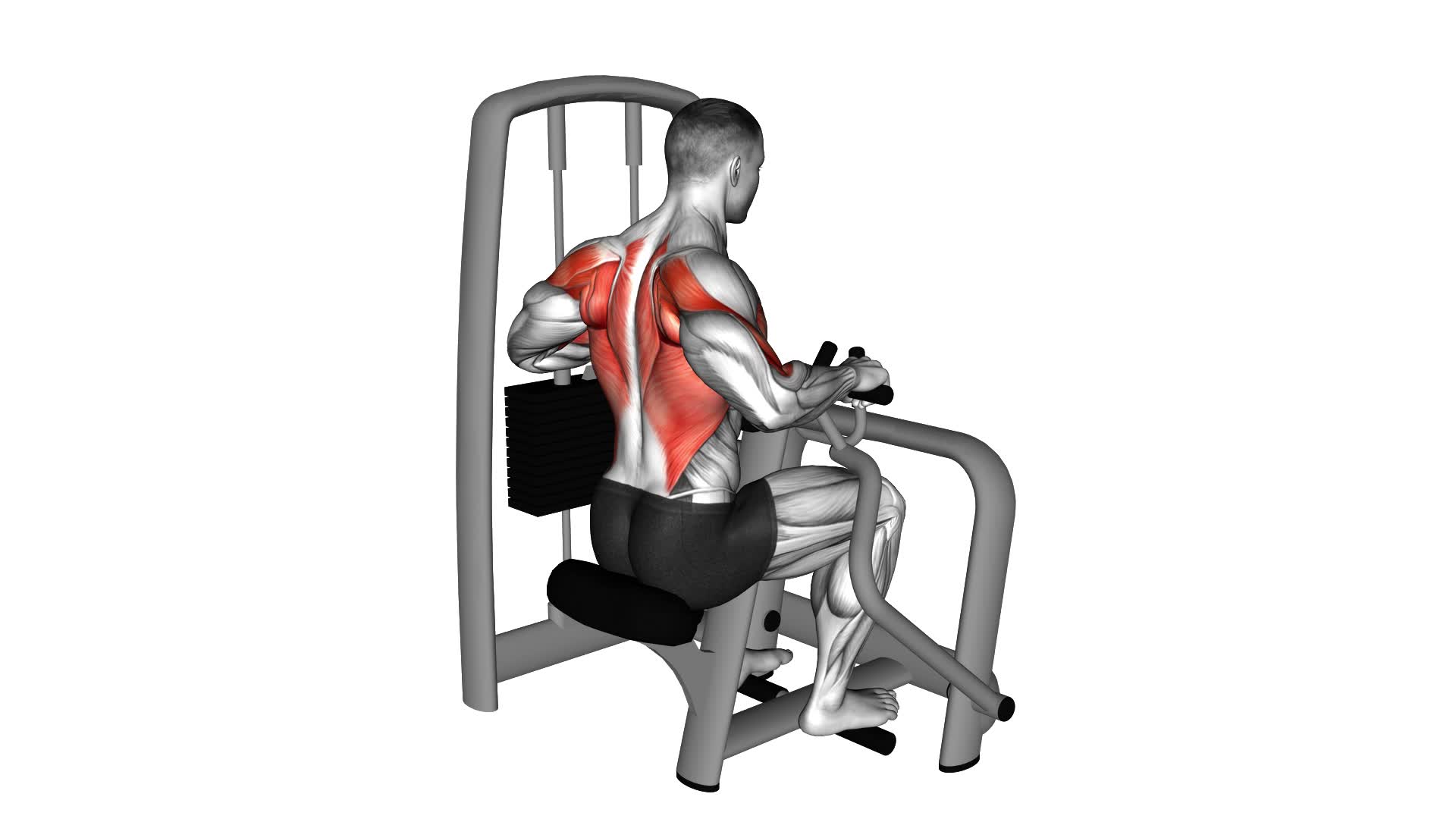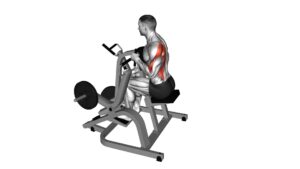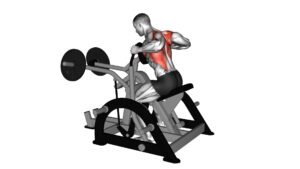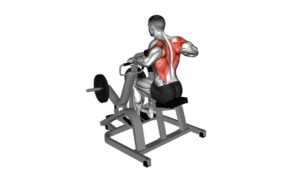Lever Seated Row – Video Exercise Guide & Tips

In this video exercise guide, you'll learn how to properly perform the lever seated row. Get ready to strengthen your back muscles and improve your posture.
Watch This Exercise Video
We'll show you the correct equipment setup and body positioning, along with step-by-step execution.
Avoid common mistakes and discover tips for progression and variation.
With our helpful video, you'll be on your way to a stronger back and better overall fitness. Let's get started!
Key Takeaways
- Warm up your muscles before starting the exercise.
- Adjust the seat height for stability.
- Beginners should start with lighter resistance.
- Incorporate different grips and resistance levels for progression and variation.
Proper Equipment Setup
To ensure optimal performance and safety, proper equipment setup is essential for executing the lever seated row exercise effectively. Before you start your workout, it's important to warm up your muscles to prevent injury and increase flexibility. This can be done through a variety of exercises such as light cardio or dynamic stretches.
Once you're properly warmed up, it's time to set up the equipment for the lever seated row.
The lever seated row machine typically consists of a seat, footrests, and a lever with handles. Adjust the seat height so that your feet are firmly planted on the footrests and your knees are slightly bent. This will provide stability during the exercise.
Next, adjust the lever handles so that they're at a comfortable distance from your body. The handles should be within reach without straining your arms or shoulders.
It is important to note that the lever seated row exercise can be modified to accommodate different fitness levels. For beginners, start with lighter resistance and focus on mastering proper form. As you progress, gradually increase the resistance to challenge your muscles. Advanced individuals can experiment with different hand placements and grip variations to target specific muscle groups.
Correct Body Positioning
Position your body correctly for the lever seated row exercise to maximize its effectiveness and minimize the risk of injury. Maintaining proper form is crucial to achieving the desired results and avoiding unnecessary strain on your muscles and joints. Here are the benefits of correct body positioning:
- Improved muscle activation: By aligning your body correctly, you can target the specific muscles you want to work on, such as the back, shoulders, and arms. This ensures that you engage the right muscles and get the most out of each repetition.
- Reduced risk of injury: Proper form helps distribute the load evenly throughout your body, reducing the risk of strain or injury. It also ensures that you maintain stability and control throughout the exercise, preventing any sudden jerking or twisting movements that may cause harm.
- Increased range of motion: Correct body positioning allows for a full range of motion, enabling you to fully contract and stretch your muscles. This promotes flexibility and mobility, leading to better overall performance and function.
- Enhanced muscle coordination: When your body is properly aligned, your muscles work together in a coordinated manner. This improves your overall strength and stability, making your movements more efficient and controlled.
Step-by-Step Exercise Execution
For an effective and safe lever seated row exercise, follow these step-by-step instructions.
- Begin by sitting on the machine with your feet firmly planted on the footrests and your knees slightly bent.
- Grasp the handles with an overhand grip, making sure your hands are shoulder-width apart.
- Keep your back straight and engage your core muscles.
- Pull the handles towards your body, squeezing your shoulder blades together as you do so.
- Keep your elbows close to your sides and exhale during the pulling motion.
- Pause for a moment when the handles are close to your torso, then slowly release them back to the starting position while inhaling.
- Repeat for the desired number of repetitions.
The lever seated row exercise primarily targets the muscles in your back, including the latissimus dorsi, rhomboids, and trapezius. It also engages the biceps and forearms as secondary muscles.
This exercise helps to strengthen and tone the muscles in your upper back, improving posture and reducing the risk of back pain. Additionally, it enhances your pulling strength, which can benefit various daily activities and sports performance.
Common Mistakes to Avoid
Avoiding these common mistakes will help you get the most out of your lever seated row exercise. Here are some technique errors to watch out for and effective muscle activation strategies to ensure you're performing the exercise correctly:
- Poor posture: Maintain proper spinal alignment throughout the exercise to prevent strain on your back. Keep your chest up and shoulders back.
- Gripping too wide or narrow: Find a grip width that feels comfortable and allows for a full range of motion. Avoid gripping too wide or narrow, as it can limit muscle activation.
- Using momentum: Avoid using momentum to pull the weight. Instead, focus on controlled movements, squeezing your back muscles at the top of the movement.
- Neglecting the full range of motion: Make sure to fully extend your arms at the start of the exercise and squeeze your shoulder blades together at the end of the movement. This will optimize muscle activation.
By avoiding these common mistakes and implementing effective muscle activation strategies, you'll maximize the benefits of the lever seated row exercise.
Now, let's move on to the next section to learn some tips for progression and variation.
Tips for Progression and Variation
To progress and vary your lever seated row exercise, try incorporating different grips and resistance levels. By using different grips, such as an overhand grip or an underhand grip, you can target different muscles in your back and arms. This helps to prevent muscle imbalances and keeps your workouts challenging. Additionally, adjusting the resistance levels can provide a greater challenge and help you continue to make progress in your strength training.
To take your lever seated row to the next level, you can also incorporate advanced techniques such as drop sets or supersets. Drop sets involve performing a set with a heavy weight and then immediately reducing the weight and continuing with more reps. Supersets involve performing two exercises back-to-back without any rest in between. This increases the intensity of your workout and helps to maximize muscle growth and strength gains.
Remember to always listen to your body and progress at a pace that's comfortable for you. Gradually increase the weight or intensity of your exercises to avoid injury and ensure continued progress. By incorporating different grips, resistance levels, and advanced techniques, you can keep your lever seated row workouts challenging and continue to see improvements in your strength and muscle development.
Frequently Asked Questions
How Many Calories Does the Lever Seated Row Exercise Burn?
The lever seated row exercise is a great way to burn calories and improve your posture. By engaging multiple muscle groups, such as your back and arms, this exercise can help you torch calories and build strength.
Not only does it provide a cardiovascular workout, but it also targets the muscles responsible for maintaining good posture.
Can the Lever Seated Row Exercise Help Improve Posture?
The lever seated row exercise can help improve your posture by strengthening your back muscles. By engaging in resistance training, you can enhance your back strength, which in turn can lead to better posture.
This exercise offers numerous benefits, such as targeting the muscles in your upper back, shoulders, and arms. Incorporating the lever seated row into your workout routine can contribute to overall better posture and improved body alignment.
Is It Recommended to Perform the Lever Seated Row Exercise With a Spotter?
If you're wondering whether it's recommended to perform the lever seated row exercise with a spotter, the answer is yes. Having a spotter can provide several benefits when performing weightlifting exercises.
They can help ensure proper form and technique, preventing injuries. Additionally, a spotter can provide assistance when lifting heavier weights, allowing you to push yourself safely.
Remember to always follow proper form and technique for the lever seated row exercise, engaging your back muscles and avoiding any jerking motions.
Are There Any Modifications or Alternatives for Individuals With Lower Back Issues?
If you have lower back issues, there are modifications and alternatives available for you. These can help you work out without putting unnecessary strain on your back.
It's important to consult with a fitness professional or physical therapist to determine the best options for your specific condition. They may suggest exercises that target the same muscle groups as the lever seated row but with less impact on your lower back.
Can the Lever Seated Row Exercise Be Performed Using Different Grip Variations?
Yes, the lever seated row exercise can be performed using different grip variations.
Changing your grip can target different muscles and increase muscle activation.
For example, an overhand grip primarily targets the upper back muscles, while an underhand grip places more emphasis on the biceps.
Experiment with different grip variations to find what works best for you and to keep your workouts challenging and effective.
Conclusion
In conclusion, the lever seated row is an effective exercise for strengthening your back muscles. By maintaining proper equipment setup and correct body positioning, you can maximize the benefits of this exercise.
Remember to avoid common mistakes and use these tips for progression and variation to continually challenge yourself.
Incorporate the lever seated row into your workout routine to improve your back strength and overall fitness.

Author
Years ago, the spark of my life’s passion ignited in my mind the moment I stepped into the local gym for the first time. The inaugural bead of perspiration, the initial endeavor, the very first surge of endorphins, and a sense of pride that washed over me post-workout marked the beginning of my deep-seated interest in strength sports, fitness, and sports nutrition. This very curiosity blossomed rapidly into a profound fascination, propelling me to earn a Master’s degree in Physical Education from the Academy of Physical Education in Krakow, followed by a Sports Manager diploma from the Jagiellonian University. My journey of growth led me to gain more specialized qualifications, such as being a certified personal trainer with a focus on sports dietetics, a lifeguard, and an instructor for wellness and corrective gymnastics. Theoretical knowledge paired seamlessly with practical experience, reinforcing my belief that the transformation of individuals under my guidance was also a reflection of my personal growth. This belief holds true even today. Each day, I strive to push the boundaries and explore new realms. These realms gently elevate me to greater heights. The unique combination of passion for my field and the continuous quest for growth fuels my drive to break new ground.







